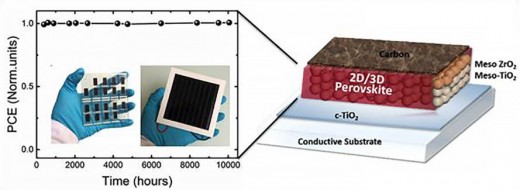One of the biggest hopes of solar energy lies in a cheap mineral called Perovskite. The material has shown promise of getting solar panels up to 31% efficiency, but have always struggled in the realm of durability. It seems that the mineral breaks down pretty quickly in the presence of water and air. Thankfully, a group of scientists in Switzerland think they’ve cracked the code on how to make the cells durable for up to 10,000 hours. The result could be a major increase in the efficiency of solar power, while also cutting the costs drastically.
The solution is a fully printable, 2D/3D perovskite solar cell. The outer 2D layer works to protect the 3D layer as it works to gather solar energy from the sun. According to the researchers, the new cells are resistant to water and oxygen damage, but still able to absorb light from the whole visible spectrum. Sadly, the current efficiency of the printed cells is resting at 11.2 percent, but it is a constant percentage that does not degrade over the course of the 10,000 hours of operation.

